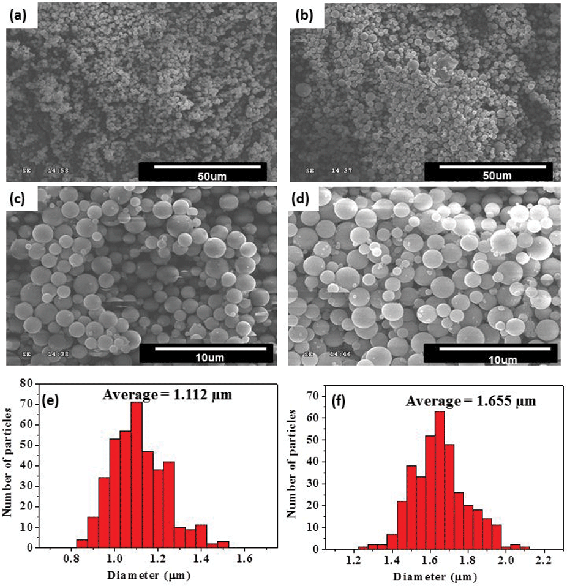
Additions and corrections
Intrinsically electroactive polyimide microspheres fabricated by electrospraying technology for ascorbic acid detection
Chang-Jian Weng, Yu-Sian Jhuo, Ya-Lun Chen, Chun-Fang Feng, Chi-Hao Chang, Shao-Wen Chen, Jui-Ming Yeh and Yen Wei
J. Mater. Chem., 2011, 21, 15666–15672 (DOI: 10.1039/C1JM12422F). Amendment published 6th August 2012.
Figure 5 in the original paper should be replaced with the new figure as shown below.

The caption for this figure should reads as follows: Fig. 5 SEM photographs of the EPS obtained from EPAA solution concentrations of (a) 2.5 wt% ( x 1 K), (b) 5 wt% ( x 1 K), (c) 2.5 wt% (x 5 K), (d) 5 wt% (x 5 K), (e) average particle size of 2.5 wt% and (f) average particle size of 5 wt%.
Some data in the main text should be corrected as follows (the changes are underlined for clarity):
1. Page 15668, right column, line 19
“When the concentration of EPAA was 2.5 wt%, the average particle size of EPS was found to be 1.176 µm. When the concentration of the EPAA solution was increased from 2.5 to 5 wt% during the electrospraying process, the EPS also increased in size from 1.176 to 1.695 µm.” should be replaced with “When the concentration of EPAA was 2.5 wt%, the average particle size of EPS was found to be 1.112 µm. When the concentration of the EPAA solution was increased from 2.5 to 5 wt% during the electrospraying process, the EPS also increased in size from 1.112 to 1.655 µm.”
2. Page 15669, left column, line 18
“Fig. 6 shows the CV of both the EPS of small particle size around 1.18 µm (EPSS) and the EPS of large particle size around 1.70 µm (EPSL).” should be replaced with "Fig. 6 shows the CV of both the EPS of small particle size around 1.11 µm (EPSS) and the EPS of large particle size around 1.66 µm (EPSL).”
The Royal Society of Chemistry apologises for these errors and any consequent inconvenience to authors and readers.
Back to article